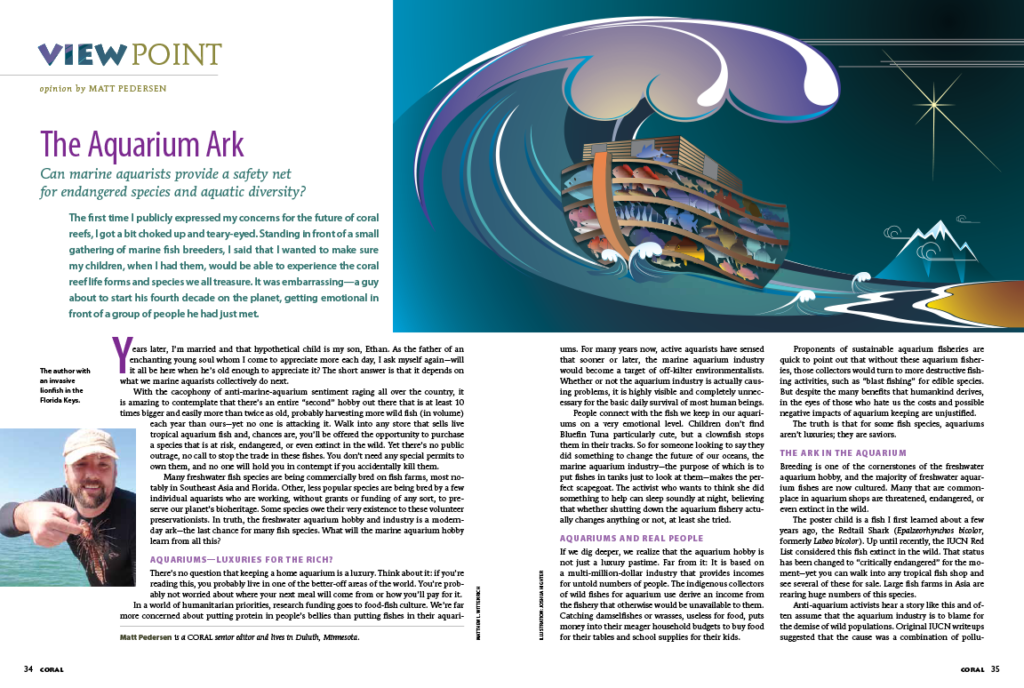
The Aquarium Ark, by Matt Pedersen, originally published in the May/June 2012 issue of CORAL Magazine.
an excerpt from CORAL Magazine, May/June 2012, by Matt Pedersen
Can marine aquarists provide a safety net for endangered species and aquatic diversity?
The first time I publicly expressed my concerns for the future of coral reefs, I got a bit choked up and teary-eyed. Standing in front of a small gathering of marine fish breeders, I said that I wanted to make sure my children, when I had them, would be able to experience the coral reef life forms and species we all treasure. It was embarrassing—a guy about to start his fourth decade on the planet, getting emotional in front of a group of people he had just met.
Years later, I’m married and that hypothetical child is my son, Ethan. As the father of an enchanting young soul whom I come to appreciate more each day, I ask myself again—will it all be here when he’s old enough to appreciate it? The short answer is that it depends on what we marine aquarists collectively do next.
With the cacophony of anti-marine-aquarium sentiment raging all over the country, it is amazing to contemplate that there’s an entire “second” hobby out there that is at least 10 times bigger and easily more than twice as old, probably harvesting more wild fish (in volume) each year than ours—yet no one is attacking it. Walk into any store that sells live tropical aquarium fish and, chances are, you’ll be offered the opportunity to purchase a species that is at risk, endangered, or even extinct in the wild. Yet there’s no public outrage, no call to stop the trade in these fishes. You don’t need any special permits to own them, and no one will hold you in contempt if you accidentally kill them.
Many freshwater fish species are being commercially bred on fish farms, most notably in Southeast Asia and Florida. Other, less popular species are being bred by a few individual aquarists who are working, without grants or funding of any sort, to preserve our planet’s bioheritage. Some species owe their very existence to these volunteer preservationists. In truth, the freshwater aquarium hobby and industry is a modern-day ark—the last chance for many fish species. What will the marine aquarium hobby learn from all this?
AQUARIUMS—LUXURIES FOR THE RICH?
There’s no question that keeping a home aquarium is a luxury. Think about it: if you’re reading this, you probably live in one of the better-off areas of the world. You’re probably not worried about where your next meal will come from or how you’ll pay for it. In a world of humanitarian priorities, research funding goes to food-fish culture. We’re far more concerned about putting protein in people’s bellies than putting fishes in their aquariums. For many years now, active aquarists have sensed that sooner or later, the marine aquarium industry would become a target of off-kilter environmentalists. Whether or not the aquarium industry is actually causing problems, it is highly visible and completely unnecessary for the basic daily survival of most human beings.
People connect with the fish we keep in our aquariums on a very emotional level. Children don’t find Bluefin Tuna particularly cute, but a clownfish stops them in their tracks. So for someone looking to say they did something to change the future of our oceans, the marine aquarium industry—the purpose of which is to put fishes in tanks just to look at them—makes the perfect scapegoat. The activist who wants to think she did something to help can sleep soundly at night, believing that whether shutting down the aquarium fishery actually changes anything or not, at least she tried.
AQUARIUMS AND REAL PEOPLE
If we dig deeper, we realize that the aquarium hobby is not just a luxury pastime. Far from it: It is based on a multi-million-dollar industry that provides incomes for untold numbers of people. The indigenous collectors of wild fishes for aquarium use derive an income from the fishery that otherwise would be unavailable to them. Catching damselfishes or wrasses, useless for food, puts money into their meager household budgets to buy food for their tables and school supplies for their kids.
Proponents of sustainable aquarium fisheries are quick to point out that without these aquarium fisheries, those collectors would turn to more destructive fishing activities, such as “blast fishing” for edible species. But despite the many benefits that humankind derives, in the eyes of those who hate us the costs and possible negative impacts of aquarium keeping are unjustified.
The truth is that for some fish species, aquariums aren’t luxuries; they are saviors.
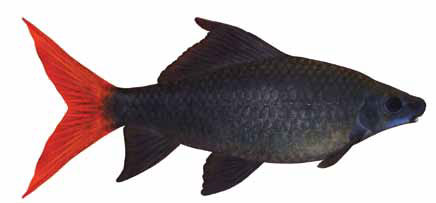
Redtail Shark, Epalzeorhynchos bicolor, preserved by aquarium breeding. Image credit: Tatjana Rittner/Shutterstock
THE ARK IN THE AQUARIUM
Breeding is one of the cornerstones of the freshwater aquarium hobby, and the majority of freshwater aquarium fishes are now cultured. Many that are commonplace in aquarium shops are threatened, endangered, or even extinct in the wild.
The poster child is a fish I first learned about a few years ago, the Redtail Shark (Epalzeorhynchos bicolor, formerly Labeo bicolor). Up until recently, the IUCN Red List considered this fish extinct in the wild. That status has been changed to “critically endangered” for the moment— yet you can walk into any tropical fish shop and see several of these for sale. Large fish farms in Asia are rearing huge numbers of this species.
Anti-aquarium activists hear a story like this and often assume that the aquarium industry is to blame for the demise of wild populations. Original IUCN writeups suggested that the cause was a combination of pollution and “much needed” dams that were built without regard for the impact they would have on fish. (IUCN has tempered the wording, and now lists the likely cause as “habitat modification.”) It appears that the Redtail Shark is a victim of human population growth and is being saved only because we happen to find it attractive.
Another ubiquitous species, the White Cloud Mountain Minnow (Tanichthys albonubes), is listed on the IUCN Red List—currently as “data deficient” but formerly as “extinct in the wild,” according to the C.A.R.E.S. Preservation Program’s citation of its IUCN status. Despite this, it is one of the undisputed best “beginner fish,” as it is able to thrive in both unheated and heated aquariums, easy to breed, extremely resilient, and quite attractive. This species is not going anywhere as long as people continue to keep aquariums. I would be genuinely shocked to walk into an aquarium store and not encounter one of the many flamboyant variants of the White Cloud now being offered.
Even though I’ve been aware of the plight of Redtail Sharks and White Cloud Mountain Minnows, I was surprised to learn that C.A.R.E.S. considers even the commonly available Boesmani Rainbowfish (Melanotaenia boesemani), endemic to only three lakes in Irian Jaya, Indonesia, to be either at risk or endangered in the wild (the IUCN lists it as endangered). Even so, I could have a guilt-free colony of Boesmani Rainbowfish at my doorstep within a week’s time. This is all possible because of captive propagation.
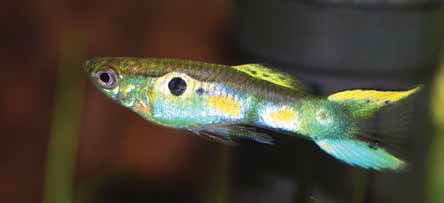
Endler’s Livebearer, Poecilia wingei: being preserved by aquarium breeding. Image credit: Dobermaraner/Shutterstock
DOMESTICATION HAPPENS
Other species are not so lucky. The livebearers are a group of very popular aquarium fishes that are farmed in large numbers. However, many of the swordtails and platies and guppies that we see in every shop are not what we think they are.
The great majority of them are domesticated forms that have been selectively bred for decades—a hybrid cocktail of numerous closely related wild species. To put this in perspective, the average swordtail or guppy is the equivalent of the Snow Onyx or Black Photon designer clownfish. What’s at risk in the livebearer world isn’t the next Platinum Percula; it’s the good old original wild forms—the classic Ocellaris Clownfish from saltwater, Endler’s Livebearer from freshwater, the natural “default” colorations and forms of species from which all our domesticated forms were derived.
Just as Ocellaris and Percula Clownfish have “cousins” that are rare or unpopular in the trade, so do the livebearers. These cousins of the guppies and swordtails don’t share the relative safety offered by commercial popularity. They are hanging on only because dedicated aquarists see the value of natural forms that wouldn’t stand a chance of capturing the casual hobbyist’s superficial tastes.
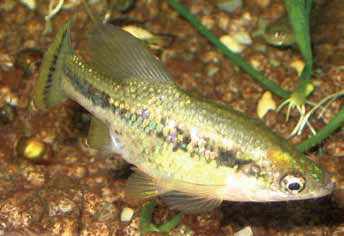
The Butterfly Goodeid, Ameca splendens: extinct in the wild? Image credit: Marie France Janelle/Creative Commons
Ameca splendens, the Butterfly Goodeid, is considered extinct in the wild by C.A.R.E.S., Fishbase, and the IUCN. However, according to the Goodeid Working Group, this species may still persist in one or more isolated remnant populations—for example, a lone springhead— but all it takes is one good drought to dry up the spring. Despite the extremely precarious existence of the Butterfly Goodeid, you can acquire this “extinct” livebearer with relative ease. As I write this in early April 2012, there are three distinct auctions for this species on Aquabid.com, and the going rate ranges from $4.33 to $10 per fish (plus shipping).
How is this possible? Quite simply, it’s an attractive but currently unpopular species of fish, so it isn’t commercially produced, but a handful of breeders keep it solely because it would otherwise be lost. It’s amazing to think that this species persists only because aquarium keepers no different than you or I value the natural biodiversity of our planet and are working to sustain it.
Ameca splendens is far from the only species with this story. Another critically endangered Goodeid, Zoogoneticus tequila, is available via multiple online auctions; one seller calls it “one of the rarest fish kept in the hobby, thought for over 40 years to be extinct in the wild, now known to be critically endangered.”
Or consider the plight of the Charco La Palma Pupfish (Cyprinodon longidorsalis). R. Kik, IV tells the story best: “This small Mexican pupfish was only just recently described in 1993. By 1998, it was extinct from its home in Nuevo Leon. This fish originally inhabited a small pool of water that was spring-fed. Due to groundwater use and over-exploitation, the pond dried up and all fish were exterminated. Luckily someone had the foresight to take a few of these fish for study, and in doing so saved the species from total extinction.” Today, this pupfish species persists in the collections of a few public aquariums, such as the Steinhart at the California Academy of Sciences, and it owes its survival to a handful of aquarists.
PUBLIC AQUARIUMS CANNOT DO IT ALONE
Too often we assume that institutions will somehow take care of all these problems. After all, we aren’t breeding gorillas, rhinos, cheetahs, Bali mynahs, or California condors in our homes. In the public’s eye, species preservation is in the purview of zoos, institutions, and nonprofits.
Species preservation is making a lot of demands on our public aquariums, which are already strapped for resources in every capacity. Perhaps the best-known institutional effort in freshwater circles (and a particular passion of mine) is the Lake Victoria Species Survival Program (LV SSP) at the Toledo Zoo Aquarium, whose North American studbook is currently managed by curator Jay Hemdal.
According to the current LV SSP studbook, there were 400 historic species of cichlids in Lake Victoria. Today, the number of species that persist in the lake (or even only in captivity) is estimated to be 200. Of those, the SSP currently maintains eight of their highest-priority species. The rest are left to fend for themselves, be it in the lake or in the hands of private and commercial aquarists. Despite truly fantastic beauty that rivals that of many marine fish, Victorian Cichlids seem to lack wide commercial popularity. I assume this is due to the drab coloration of most females and the disappointing hybrids created by ignorant or indiscriminate breeders passing off culls as more desirable forms. Victorian Cichlids have become a “hobbyist” fish for the most part. Indeed, cichlid experts and conservation breeders Dr. Paul V. Loiselle and Jay Hemdal credit a single Swedish aquarist, Bo Selbrink, with allowing the extinct-in-the-wild Prognathochromis perrieri to persist in captivity. That’s right: it only took a single private aquarist to save a species from extinction.
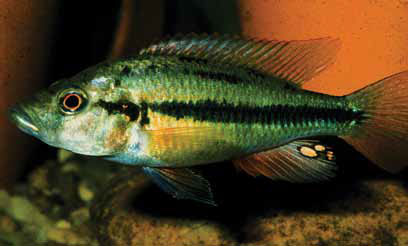
Prognathochromis perrieri: one of many Lake Victoria cichlid species extinct in the wild but kept alive by conservation breeders. Image credit: Paul V. Loiselle
THE C.A.R.E.S. PRESERVATION PROGRAM
To that end, C.A.R.E.S. seeks to address the need for captive preservation of fishes in the tanks of hobbyist aquarists, which would provide far more capacity than anything institutions can provide. To date, C.A.R.E.S. mainly covers freshwater species (the only marine species evaluated and listed are the seahorses, Hippocampus spp.). The priority list maintained by C.A.R.E.S. provides an at-a-glance assessment of troubled fish species within various interest groups. Leaders in the freshwater aquarium hobby have embraced C.A.R.E.S. to the extent of encouraging every hobbyist breeder to maintain at least one tank in his or her fish room dedicated to propagating a C.A.R.E.S. priority listed species.
Should C.A.R.E.S. cross the halocline and examine more marine fish? I believe they should, and I think we should be ready to support and embrace the effort. As the marine breeding subculture grows and the pressures facing our coral reefs continue to pile up, there is a definite need for thoughtful leadership and responsibility among marine aquarists. We should learn from and follow the example of our freshwater counterparts. If we choose to be proactive and conservation-minded, I am confident that we can make sure that the biodiversity we treasure (including the species we find less than attractive) is around for our children to admire in the future.
MARINE FISH OF CONCERN
It’s my opinion and understanding that freshwater fish are inherently more at risk of extinction than marine fish for a simple reason: they are often far more geographically restricted. If a species is found only in one 40-acre body of water, we only need to over-collect that species or poison, drain, or dry up its habitat to wipe it out.
For most of our coral reef species, it’s not necessarily so easy. Long pelagic larval phases allow species to drift, like seeds in the wind, from reef to reef across vast expanses of ocean. Many species have wide or even circumtropical distributions, which means that the loss of a particular reef may not extirpate the species from the planet. In fact, I have tried but failed to find a specific record of a single ornamental marine fish extinction. Of course, the larger looming concern is the global threats to coral reef habitats that know no specific geographic boundary. All it takes in our game of oceanic roulette is for the wrong reef to suffer a catastrophic event, and we could lose something quite irreplaceable.
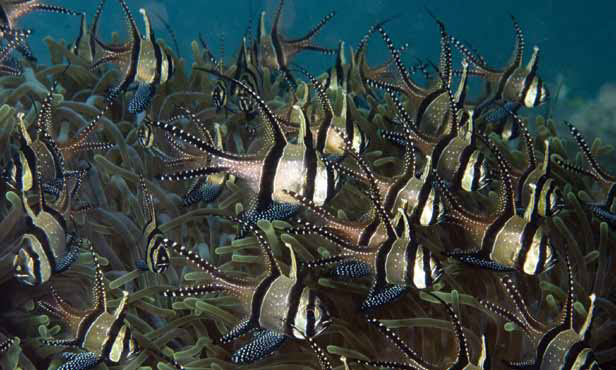
Banggai Cardinalfish, Pterapogon kauderni: listed as endangered in its native waters but entrenched in the aquarium world. Image credit: Dray van Beeck/Shutterstock
A CONTROVERSIAL EXAMPLE: THE BANGGAI CARDINALFISH
The Banggai Cardinalfish (Pterapogon kauderni) is a perfect example of this. The most recent collection data suggests that we harvest as much as 50 percent of the population of this species every year for the marine aquarium trade, yet it is one of the most geographically restricted species we keep in our aquariums. The total available habitat within its natural range is cited as 34 square kilometers, or roughly 13 square miles. To put this in planetary perspective, my boyhood hometown of Riverwoods, Illinois, covers about 4 square miles, and my current city of residence, Duluth, Minnesota, covers approximately 87 square miles. So the entire population of Banggai Cardinalfish may well reside in a space about the same size as the city you live in.
While we can say with some certainty that the Banggai Cardinalfish will likely persist in captivity with captive breeding, its status in the wild is a hot topic of debate. Marine species with restricted geographic ranges (and likely smaller population sizes) are the most susceptible to catastrophic population crashes from any cause. The Banggai Cardinalfish is not alone in this regard; it is simply the most publicized species due to the IUCN’s listing of it as an endangered species in 2007.
AT-RISK ANGELFISH
The extremely rare-in-the trade Resplendent Angelfish (Centropyge resplendens) is found only at the Ascension Islands in the mid-Atlantic. It used to be commonly available, but governmental restrictions on wild collection have made it extremely expensive and only available as a captive-bred fish in recent years. Meanwhile, another rare-in-the-trade angelfish, the Joculator Angel (C. joculator) from the Cocos-Keeling Islands, is slightly more obtainable, but because only one individual has permits and export capability, all the specimens you’ll see come from that one source (John Coppolino, pers comm). Both C. resplendens and C. joculator have been successfully bred in captivity by Frank Baensch, but commercial production is not happening. It’s still conceivable that C. joculator could once again be produced through captive breeding if fresh broodstock were obtained, but whether we should expect to see any more C. resplendens in the future remains to be seen.
While the IUCN lists Centropyge resplendens and C. joculator as species of least concern at this time, the same cannot be said for the related Nahakyi’s Pygmy Angelfish (C. nahakyi), found only at Johnston Atoll, a starkly restricted geographic range. IUCN currently considers C. nahakyi to be “near threatened,” citing the limited range combined with the threat of El Niño weather events, which cause localized environmental problems. If C. nahakyi could be introduced to the marine aquarium trade and maintained by breeding, it would provide a valuable backup population, should something happen to the wild population at Johnston Atoll.
The Clipperton Angelfish (Holacanthus limbaughii), known only from Clipperton Island, is thought to have a total range of less than 4 square miles (10 sq km). This is less than one-third of the habitat available to the aforementioned Banggai Cardinalfish. Once again, IUCN lists this species as “near threatened” for the same reasons as Centropyge nahakyi.
PROTECTED SEAHORSES
All species of seahorses are considered endangered and regulated by CITES (Convention on International Trade in Endangered Species). Still, thanks to captive breeding, many of us are able to keep these animals in our homes. Regardless of the natural future for seahorses, a handful of popular aquarium species should persist well into the future as long as we keep buying them from breeders.
On the IUCN Red List, most Hippocampus are listed as either “data deficient” or “vulnerable” in status, with one notable exception. The Knynsa or Cape Seahorse, H. capensis, is listed as an endangered species due to fragmented populations and habitat loss as a result of development. Ironically, this species was being bred and sold in the aquarium trade for a number of years by Ocean Rider in Hawaii. According to posts on the popular Seahorse.org discussion forums, it appears that this species may be lost to the hobby and now couldn’t be legally reintroduced because CITES regulations and South African law prevent collection. The only way hobbyists might acquire them is to obtain excess captive-bred individuals released from a public aquarium that still has them, but this is generally a rare occurrence.
Ironically, with Ocean Rider producing Hippocampus capensis commercially, the handful of hobbyist seahorse breeders apparently didn’t see it as a species in need of immediate and deliberate private propagation efforts. Ocean Rider tells us they still produce and maintain H. capensis, but are eager to diversify their broodstock population. It’s disappointing to consider that if the Cape Seahorse is lost in the wild, it may have missed its chance to persist in captivity because hobbyists didn’t have the foresight to help “ark” it when we had the chance.
CLOWNFISHES: “CLASSICS” OF THE MARINE WORLD
I have been known to rant about clownfishes, because they are the most popular group I’ll mention, and yet they include some of the most at-risk species. Case in point: the Mccullochi Clownfish (Amphiprion mccullochi, shorthanded Mcc), which is only known from Lord Howe Island and possibly Norfolk Island. With just one or two small, localized weather catastrophes, this species could quite easily become extinct in the wild. Thankfully, we do have a small captive population going, but in order for the Mccullochi to be preserved in captivity, we need more people maintaining breeding pairs and watching their lineages closely.
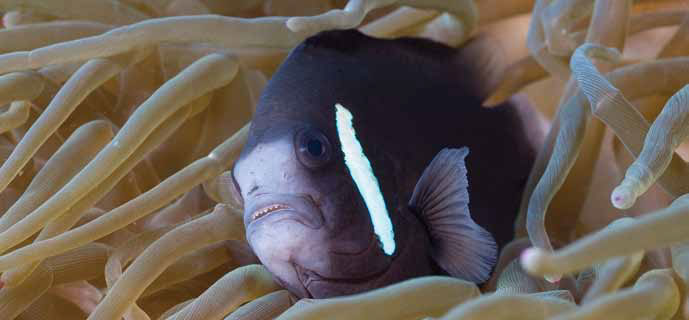
McCulloch’s Anemonefish, Amphiprion mccullochi, a species with very limited range in the wild and thus vulnerable to catastrophic weather and environmental events. Image credit: Frank Baensch/ www.bluereefphoto.org
Of course, the Mcc isn’t the only clownfish in a precarious position. The Chagos Anemonefish (Amphiprion chagosensis), unknown to the trade, shares a similarly restricted geographic distribution. Since the Chagos Clownfish isn’t collected and isn’t being bred, a captive ark failsafe doesn’t exist for this species. Chagos lost 90 percent of its reefs during a bleaching event in 1997– 1998. Luckily, it has recovered to about 50 percent coral cover, according to the Zoological Society of London, but I have to wonder: What if that bleaching event had been 100 percent? Would I now be writing about the first documented extinction of a clownfish species?
Of growing concern is the fact that we have only recently become more aware of the many geographical variants that exist among clownfish. Certain commercial breeders (most recently Sustainable Aquatics) are taking steps to obtain and breed these unique varieties, including the many forms of the Cinnamon Clownfish (Amphiprion melanopus). In March/April of 2012, Sustainable Aquatics made available both the polymorphic stripeless Coral Sea variant and a beautiful Blue Stripe variation from New Caledonia. These geographical variants are important because we don’t always have a firm understanding of what a species is. A classic example is Amphiprion barberi from Fiji, which was considered first a wayward population of the western Australian A. rubrocinctus, and then an unusual form of A. melanopus, before finally being recognized as the distinct species it is. Keeping clean geographic breeding lines ensures that we preserve biodiversity that we may not fully understand. However, the most critical issue is again one of limited geographic range—while we may not ever lose the Cinnamon Clownfish as a species, we could easily lose the white-tailed variation from the Solomon Islands.
But perhaps the most interesting dilemma in the saltwater breeding today is the ongoing struggle between “designer” clownfish varieties and their wild ancestors. I alluded to this earlier when discussing the classic fishes of the freshwater hobby. If the general hobbyist’s preference for “Picasso” Percs and “Black Photon” hybrids continues, will we even be able to get the wild forms of clownfish as captive-breds? It’s important to realize that you can’t often “go back” to the wild forms from domesticated varieties, and even more important, you can never “undo” hybridization. Faced with a never-ending onslaught of brand new cultivated varieties commanding top dollar (the latest is a new Picasso-type form of Amphiprion sebae shown off by Bali Aquarich), is it going to fall to the basement hobbyist to keep propagating the original wild forms of our clownfish species? Or will my now hypothetical grandchild only know that clownfish had three stripes because he watched a 4-D holographic version of the movie Finding Nemo?

Author’s son Ethan, enthralled by Rock Beauties and Florida gorgonians in one of the family’s display aquariums. Image credit: Renee Pedersen
OUR CHILDREN’S FISHES
So what aquarium fishes will be here when our children or grandchildren come of age and have their first aquariums? I believe that the concept of “arking” fishes, not to mention corals, is really about the entire next generation. So long as we are still able to keep aquariums, aquarists around the world will continue to propagate fishes, plants, corals, and other livestock. As long as our children appreciate and admire the natural world, as long as we make it a point to instill that appreciation in them, we will preserve at least part of our natural heritage for future generations. Perhaps they will judge us less harshly if we have tried to save as much as we could.
At latest count we’re hovering around 200 species of ornamental marine fish that have been bred at least once, out of 1,500 to 2,000 marine species we currently keep (not including the additional number of geographical and manmade variants). Being bred once is not a golden ticket to salvation for a marine fish species. An informal survey of commercial producers suggests that approximately 60 species are being produced routinely and benefit from a precarious status in our marine aquarium world: if we continue to purchase them as captive-bred fish, if commercial breeders keep working with them, they will have the luxury of being already “arked” by our hobby and by our industry. They could be eliminated from the world’s oceans (or banned from wild harvest) and still exist in captivity.
Where we go next is yet another great debate, but one thing is clear to me. If we can breed it, we should, so we’re not caught off-guard by changing climate or legal barriers to wild harvest. If we can’t yet breed it, we should be given the opportunity to try, so the species has a chance to get into the safety net. This isn’t to say that captive-bred fish are the only answer, but rather that captive breeding provides a backup in case our other options evaporate. Captive breeding is the aquarist’s gift back to the world. Our freshwater counterparts have more than demonstrated that while commercial demand will secure many species, dedicated hobbyists must accept the responsibility of preserving and advocating for the rare, unusual, or less colorful species that commercial breeders ignore.
The marine aquarium hobby and industry may be vilified by some, but let’s keep our eyes on the prize—ensuring that as many species as possible will persist with our stewardship—regardless of what’s happening in the larger world, outside our sphere of influence.

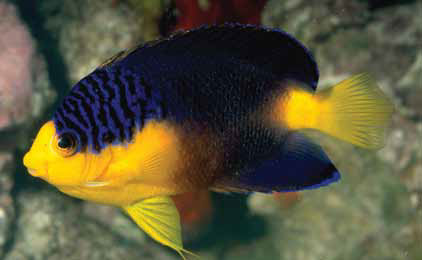





Matt,
Excellent article! And I really enjoyed your talk to GVAC recently. Breeding fish is my passion also. I was disappointed when FAAS ended their BAP program, as it motivated many to breed more fish, including myself.
Chase Klinesteker
Chase, GVAC was an exceptional group of folks…seriously…like 40 people on hand at a FW club to hear me talk about SW Fish Breeding in AUGUST? I gotta learn a thing or two from you guys on how to energize a club like that! My thanks to you all for having me!